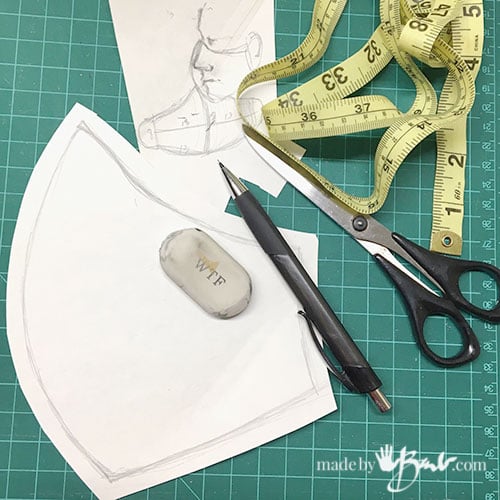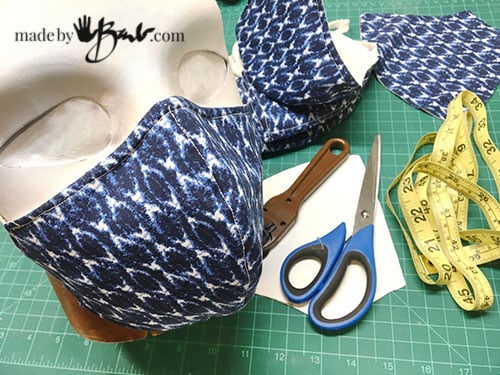DIY Fitted Face Mask

What has everyone been up to?! Yes, do not roll your eyes… I have a lot of fabric and abundance of ideas. I’m just keeping hands busy and mind content. My gift to you; a DIY fitted face Mask with pattern.

Yes, I know!
I know, I know; before you tell me that this mask will not replace a N95, I know. Depending what fabric you use will depend on the amount of particulates it will filter. There is some interesting data here. I’m not a scientist, but I can draft a pattern.
I’m a maker, and spending safe time in my house I wanted to be productive and make a difference for those I care for if even just a tiny bit. DISCLAIMER: I am not giving any assurance that this will protect you from all airborne virus or like. Research carefully and make your own decisions.
My main purpose is to make a mask that fits me as I like. My international students have the etiquette to wear masks even in the best of times many years ago and I have marvelled at how stylish and comfortable some are.
You will need:
- Fabric (t-shirt knits, tight weave cotton, dish towel fabric, vacuum bags)
- Thin elastic (1/8″ – 1/4″)
- soft bendable wire
- sewing machine, thread scissors…
- PATTERN

Using my ‘mug’ and a mask I designed this pattern (print full size, no reduction on letter size paper) to fit over the nose and give space for the lips. Yes, it has a seam down the middle, you choose. Some have pleats and are quite flat. I find the leakage around the nose can be a problem, and this has a wire shaping as well.

In my research for fabric and material I found that vacuum bags provide good filtration. I do have some HEPA vacuum bags, which have 3 layers. One thing to consider is comfort and breathability and the vacuum bags work quite well.
UPDATE: I am getting a lot of comments about the possibility that these vacuum bags have fibreglass in them. It seems to be a debate, so please choose wisely. This article also addresses it.

One way to help make them more efficient is to layer, as I did here with 3 layers. Cut 2 pieces of each layer. Such a great way to use up some of the scraps of ice-dyed t-shirt fabric.

Easy Assembly:
Double up 2 layers and with right sides together, sew the front centre seam. Sew a 3/8″ centre seam of lining as well.

Since every face is different, it a good idea to make a test one. Adjust as you like from there. Here centre seam is sewn.

To keep the shape I press open the centre seam and stitch flat.

This will keep the form of the mask firm.

Since the seams may get thick trim back at top and bottom.

Just like a Pillow:
To join the inside to the outside, is much like making a pillow; sew all the way around (right sides together) and leave an opening to turn right side out.
Note: If you want to attach elastic before turning add to each piece at dots marked on pattern and loop inside. I like the option of adding later so that adjustments can be made; your choice.

After sewing clip corners off without cutting stitches and trim seam allowance as close as possible.

Such a nice shape:
Turn right side out and push corners out with a chopstick or skewer.

The nose bridge fits better if wire is inserted. I used a thin floral wire that it a slight bit stronger than a twist tie. Bend in the ends for safety. An alternate way is to use wired ribbon. Another great option is to use strips cut from tin cans (like the top flap of a sardine can or tomato can) See this post for details on how to make it iron-in.

Before top stitching the perimeter of the mask, insert the wire as close to edge as possible and pin/clip. Top stitch all around and close the opening.

To add elastic after turning loop a bit under so it is 2x secure and stitch on.
UPDATE: Due to some shortage of elastic, An alternate is using some t-shirt fabric cut in 3/4″ strips. It rolls when pulled and has some stretch and is soft on the ears. You can also adapt this Pattern to have a casing and open ends for filter pocket. See this post.

The Form & Fit:
The fit is quite comfortable. To size smaller a slight reduction in print size can work.

Everyones nose is different! If you like, you can reduce the height as seen on pattern. The nose wire can be shaped well to fit around your’s.

I wear glasses so I always find issues when wearing my masks for concreting! Yup, when you are a ‘designer’ you are much fussier!
If you would like an even flatter fit over the nose for glasses see this pattern as an adaptation of this pattern. We are all quite different (imagine how many fits of jeans we have)

This mask scoops under that chin of mine as well!

TADA! I can feel a bit better. I especially like the ‘vacuum bag’ face masks. They should be cleaned washed after each use. I would not just through them in the washer due to the wire. If you put them in a bag the heat of the dryer will hopefully kill anything.
Some more effectiveness can also be had by spraying the fitted face mask with a solution of citric acid and allowing to dry. Leaving them in the sun lets the UV also disinfect. Again, do your research and make good choices.

I’d rather be making pretty things than medical supplies or a fitted face mask… But this gives a bit of comfort anyways. DO be careful out there my friends!

See the look in my eyes!? The wonder, the caution, the hope of better times soon… but as a very very wise person said to me quite often; things coud be much worse so be grateful.
Yup, it’s odd, I’m a grandma now but I really wish my ‘Mommy’ was here to reassure me right now…
As a chid I used to watch my mom design fashionable hats from scratch; so now it’s my destiny to design some masks… like this and this.
I’m not sure if I’m just really stupid, but I cannot figure this pattern out. I’ve been following it and all of the pictures look exactly like what I’ve done. I can’t flip it like a pillowcase, it just doesn’t work.
Yes, because there was 3 layers, and 2 were sewn together and topstitched as one, then the other layer and turned. I’m sorry for the confusion.
how would we make the mask without having to sew it up in the middle???
Sew the outside pieces at centre seam and then lining at centre seam. Then treat like a pillow, stitch around the outside, leaving an opening and then turn it. Hope that helps!